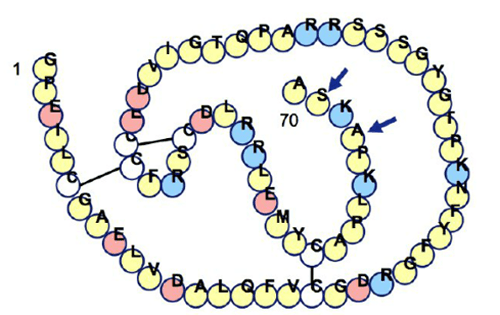[…] the legitimate medical use of substances. When these compounds are misused, it constitutes a breach of ethics both by the user and supplier. Effects of PEDs: Athlete Stories VIDEO TRANSCRIPT Anabolic Agents (Including Testosterone) The primary medical use of these compounds is to treat delayed puberty, some types of impotence, and wasting of the body caused by HIV infection or other muscle-wasting diseases. What are some potential side effects of anabolic steroid abuse? Some physiological and psychological side effects of anabolic steroid abuse have potential to impact any user, while other side effects are gender specific. The following list is not comprehensive. https://vimeo.com/388513559 VIDEO TRANSCRIPT VIDEO TRANSCRIPT Physiological Acne Male pattern baldness Liver damage* Premature closure of the growth centers of long bones (in adolescents) which may result in stunted growth* Stunted growth and disruption of puberty in children Psychological Increased aggressiveness and sexual appetite, sometimes resulting in abnormal sexual and criminal behavior, often referred to as “Roid Rage” Withdrawal from anabolic steroid use can be associated with depression, and in some cases, suicide Gender Specific – Males Breast tissue development* Shrinking of the testicles* Impotence Reduction in sperm production Gender Specific – Females Deepening of the voice* Cessation of breast development Growth of hair on the face, stomach and upper back* Enlarged clitoris* Abnormal menstrual cycles NOTE: * Effects may be permanent and can vary by individual. Peptide Hormones, Growth Factors, and Related Substances The primary medical use of these compounds vary, but include treatment of cancer or aiding those born prematurely. The presence of an abnormal concentration of a hormone, its metabolites, relevant ratios, or markers in your sample is deemed to contain a prohibited substance unless you can demonstrate the concentration was due to a physiological or pathological condition. Examples include human growth hormone (hGH), erythropoietin (EPO), insulin, human chorionic gonadotrophin (HCG), and adrenocorticotrophin (ACTH). Despite the presence of some growth factors, platelet-derived preparations were removed from the List as current studies on PRP do not demonstrate any potential for performance enhancement beyond a potential therapeutic effect. Physiological Hypertension (EPO/hGH) Blood cancers/leukemia (EPO/hGH) Anemia (EPO) Strokes (EPO) Heart attacks Pulmonary embolism (EPO) Feminization (HCG) Thyroid problems (hGH) Note that individual growth factors are still prohibited when given separately as purified substances as described in S.2.5. Human Growth Hormone (hGH) Physiological Severe headaches Loss of vision Acromegaly (Protruding or enlarged jaw, brow, skull, hands and feet) High blood pressure and heart failure Diabetes and tumors Crippling arthritis Beta-2 Agonists The primary medical use of these compounds is to treat conditions such as asthma and other respiratory ailments. Some studies have shown beta-2 agonists have performance-enhancing effects when consistently high levels are present in the blood. Physiological Palpitations Headaches Sweating Nausea Muscle cramps Nervousness Diuretics The primary medical use of these compounds is to treat conditions such as hypertension, kidney disease, and congestive heart failure. Taken without medical supervision, diuretics can result in potassium depletion and possibly even death. Physiological Dehydration Muscle cramps Dizziness or fainting Drop in blood pressure Loss of coordination and balance Stimulants The primary medical use of these compounds is to treat conditions such as Attention Deficit Hyperactivity Disorder (ADHD), asthma, narcolepsy, and obesity. Physiological Insomnia Anxiety Weight Loss Dependence and addiction Dehydration Tremors Increased heart rate and blood pressure Increased risk of stroke, heart attack, and cardiac arrhythmia VIDEO TRANSCRIPT Cannabinoids (Marijuana) Marijuana is classified by Congress as a Schedule 1 drug under the Controlled Substances Act (CSA). This means that it has a high potential for abuse, no accepted medical use in the United States, and lacks accepted safety data for use under medical supervision. Side effects of cannabinoid use include: Physiological Increased heart rate Impaired short-term memory Slowed coordination and reaction of reflexes Diminished ability to concentrate Distorted sense of time and space Respiratory diseases Psychological Mood instability Impaired thinking and reading comprehension Blood Doping Blood doping is the practice of misusing certain techniques and substances to increase the red blood cell mass in the body. Since the red blood cells carry oxygen to the muscles, this allows the body to transport more oxygen to working muscles and therefore can increase their aerobic capacity and endurance. There are three widely known substances or methods used for blood doping, namely, erythropoietin (EPO), synthetic oxygen carriers, and blood transfusions*. The primary use of blood transfusions and synthetic oxygen carriers are for patients who have suffered massive blood loss, either during a major surgical procedure or caused by major trauma. Erythropoietin is used in the treatment of anemia related to kidney disease. However, misuse of these substances and techniques could lead to: Physiological Increased stress on the heart Blood clotting Stroke *With transfusions, there is an increased risk of infectious disease such as AIDS or hepatitis. https://vimeo.com/388513596 VIDEO TRANSCRIPT Narcotics In small doses narcotics have medical uses that include relieving severe pain and inducing sleep. However, narcotic overdose is a medical emergency and can lead to respiratory depression and even death. While a sensation of euphoria and psychological stimulation are effects common to the use of narcotics, the misuse of narcotics can pose ethical questions about the handling of the substance as well as great health risks. Those include -> Physiological A false sense of invincibility Nausea and vomiting Increased pain threshold and failure to recognize injury Decreased heart rate Physical and psychological dependence; leading to addiction […]











